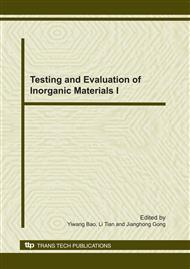p.129
p.132
p.136
p.140
p.144
p.148
p.151
p.154
p.157
Ultra-High-Hardness (Ti, W)C Matrix Metal Ceramics Prepared through Combustion Synthesis under High Gravity
Abstract:
(Ti, W)C matrix metal ceramics were prepared through combustion synthesis under high gravity, structure formation mechanism of the ceramics was discussed and the properties of the ceramics were also measured. XRD and FESEM images show the matrix of metal ceramics was mainly composed of TiC and (Ti, W)C1-x. The formation mechanism mainly involves two stages: firstly, combustion reaction is advanced rapidly under high gravity, and the layered melt consisting of Ti-W-Fe-C-B liquid at the bottom and oxide liquid at the top is formed due to rapid liquid-liquid separation under high gravity, subsequently, TiC solids as the primary phase precipitates from Ti-W-Fe-C-B liquid due to the higher concentration and faster diffusion of C relative to B in the alloy liquid, whereas (Ti, W)C1-x solid nucleates and grows on the surface of TiC solids. The Vickers hardness, flexural strength and fracture toughness of the (Ti, W)C matrix Metal ceramics measured 25.6 GPa, 1060 MPa and 8.5 MPa•m1/2, respectively.
Info:
Periodical:
Pages:
144-147
Citation:
Online since:
December 2010
Authors:
Price:
Сopyright:
© 2011 Trans Tech Publications Ltd. All Rights Reserved
Share:
Citation:


